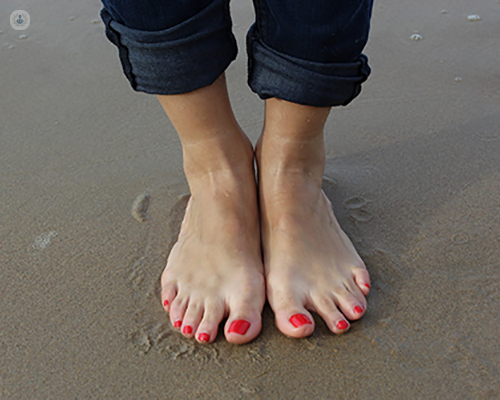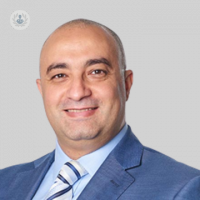Exploring ankle arthroscopy
Escrito por:In his latest online article, Mr Hisham Shalaby gives us his insights into ankle arthroscopy. He talks about what it is, the procedure, common conditions or injuries, recovery and rehabilitation, risks or complications and how long it takes to resume normal activities.

What is ankle arthroscopy and how is it performed?
Ankle arthroscopy is a minimally invasive surgical procedure in which a high-resolution camera is inserted into the ankle joint through a small incision. Additional specialised instruments are introduced through a separate incision. These instruments enable the performance of various intra-articular procedures, ranging from addressing inflamed tissue, removing excessive bone, managing loose cartilage, repairing the joint surface, mending ligaments, to even more complex tasks like ankle joint fusion. The primary advantage of this approach is that it eliminates the need for open joint surgery, resulting in enhanced precision. The camera and instruments grant access to areas of the joint that are typically challenging to reach using conventional open surgery.
What are the common conditions or injuries that can be treated with ankle arthroscopy?
Arthroscopy offers a range of surgical options, with one of the most common applications being the treatment of inflammatory conditions involving joint lining inflammation. In such cases, arthroscopy is employed to meticulously remove and cleanse the inflamed tissue. Additionally, arthroscopy can effectively address ankle arthritis, with treatment options encompassing the removal of excess bone and joint preparation, including fusion using screws.
Another condition addressed through arthroscopy is osteochondral lesions, typically resulting from sports injuries. Arthroscopy excels in this context, enabling the removal of loose cartilage, cleansing and preparing cartilage lesions, and stimulating bone surface healing through drilling.
The fourth commonly treated condition via arthroscopy is ankle instability. This procedure facilitates dynamic diagnosis by assessing joint movement and applying stress in various directions under direct visual guidance. This evaluation helps determine joint stability and identifies any damaged ligaments. Arthroscopy also allows for the assessment of the syndesmosis joint, which connects the tibia and fibula. Once again, this can be dynamically evaluated with arthroscopy. Moreover, arthroscopic-assisted procedures for ligament repair can be performed without the need for open joint surgery.
What can I expect during the recovery and rehabilitation process after ankle arthroscopy?
Typically, ankle arthroscopy is conducted as an outpatient procedure, allowing patients to return home the same day. Following the surgery, patients are usually provided with a Velcro boot to maintain the ankle at a 90-degree angle, preventing calf muscle tightness. In most cases, patients are encouraged to gradually resume partial to full weight-bearing, often aided by crutches for improved balance.
Any sutures are typically removed within a few weeks. Patients are also commonly referred to physiotherapy and rehabilitation programs tailored to specific protocols. These programs encompass core muscle strengthening, calf stretching exercises, range of motion exercises, tendon strengthening exercises around the ankle, proprioceptive training, and balance exercises. These are all areas where physiotherapists play a crucial role. The speed of recovery depends on the type of operation performed. Simpler procedures generally lead to faster recoveries, while more complex surgeries involving joint surface work or cartilage lesion reconstruction may result in a much slower recovery.
Are there any risks or complications associated with ankle arthroscopy surgery?
Similar to any surgical procedure, ankle arthroscopy carries its own set of potential risks and complications. However, it's important to note that these risks are significantly lower when compared to similar open surgeries.
The most frequently encountered issue following arthroscopy is swelling, which can persist for a certain duration. Additionally, there is a minimal risk of superficial nerve injury, which could lead to numbness in or around the arthroscopy incision sites. Infection is also a rare occurrence in arthroscopic procedures, with a substantially lower rate compared to open surgeries. These are the most commonly reported complications.
How long does it typically take to return to normal activities and sports after ankle arthroscopy?
The pace of recovery naturally varies based on the specific procedure performed. It's important to emphasise that the recovery process is consistently gradual, not immediate. Typically, patients can return relatively quickly to non-impact exercises such as swimming and cycling, particularly in sports that don't involve physical contact. However, for contact sports, the recovery timeline tends to be longer. In most cases, patients are no longer wearing the boot within or even before six weeks, at which point they commence physiotherapy-led rehabilitation, gradually increasing their activities in small increments from the sixth week onward.
Mr Hisham Shalaby is a distinguished orthopaedic surgeon with over 20 years of experience. You can schedule an appointment with Mr Shalaby on his Top Doctors profile.


